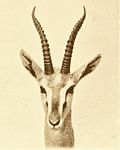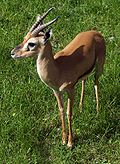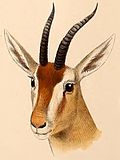Superregnum: Eukaryota
Cladus: Unikonta
Cladus: Opisthokonta
Cladus: Holozoa
Regnum: Animalia
Subregnum: Eumetazoa
Cladus: Bilateria
Cladus: Nephrozoa
Superphylum: Deuterostomia
Phylum: Chordata
Subphylum: Vertebrata
Infraphylum: Gnathostomata
Megaclassis: Osteichthyes
Cladus: Sarcopterygii
Cladus: Rhipidistia
Cladus: Tetrapodomorpha
Cladus: Eotetrapodiformes
Cladus: Elpistostegalia
Superclassis: Tetrapoda
Cladus: Reptiliomorpha
Cladus: Amniota
Cladus: Synapsida
Cladus: Eupelycosauria
Cladus: Sphenacodontia
Cladus: Sphenacodontoidea
Cladus: Therapsida
Cladus: Theriodontia
Subordo: Cynodontia
Infraordo: Eucynodontia
Cladus: Probainognathia
Cladus: Prozostrodontia
Cladus: Mammaliaformes
Classis: Mammalia
Subclassis: Trechnotheria
Infraclassis: Zatheria
Supercohors: Theria
Cohors: Eutheria
Infraclassis: Placentalia
Cladus: Boreoeutheria
Superordo: Laurasiatheria
Cladus: Euungulata
Ordo: Artiodactyla
Cladus: Artiofabula
Cladus: Cetruminantia
Subordo: Ruminantia
Familia: Bovidae
Subfamilia: Antilopinae
Genus: Eudorcas
Species: E. albonotata – E. rufifrons – ?E. rufina – E. thomsonii – E. tilonura
Name
Eudorcas Fitzinger, 1869
References
Eudorcas in Mammal Species of the World.
Wilson, Don E. & Reeder, DeeAnn M. (Editors) 2005. Mammal Species of the World – A Taxonomic and Geographic Reference. Third edition. ISBN 0-8018-8221-4.
Vernacular names
Ελληνικά: Ευδορκάς
Eudorcas is a genus of antelope; the species are commonly called gazelles. Eudorcas was originally considered a subgenus of the genus Gazella but has since been elevated to generic status.[1] The five species within the genus Eudorcas are:
Species[1]
| Image | Scientific name | Subspecies | Common Name | Distribution |
|---|---|---|---|---|
 |
E. albonotata | Mongalla gazelle | South Sudan | |
 |
E. rufifrons | south of the Sahara
|
Red-fronted gazelle | south of the Sahara |
 |
E. tilonura[2] | Heuglin's gazelle | Sudan, Eritrea and Ethiopia | |
 |
E. rufina | Red gazelle† | Algeria | |
 |
E. thomsonii |
|
Thomson's gazelle | East Africa |
Social structure and behavior
Red fronted gazelle - Middle Africa
The social structure of gazelles consists of several types of groups. Male gazelles are territorial throughout their adult lives, though not usually before two to three years of age. During the nonterritorial periods, males usually spend their time in bachelor groups or as part of a mixed herd. Likewise, females will form migratory female groups that travel through the males' territories. As the female groups pass through, the territorial males will try to herd them to prevent them from leaving. Adult males with adjoining territories will engage in combat several times a day, fighting with their horns to establish dominance and the boundaries of their territories. In this way, the accepted boundaries of the territory can change on a daily basis. If a lone male, a bachelor group, or in some cases even an adolescent male fawn of a female gazelle should be passing through a territorial male's region, the male will chase the offender out of his territory. This territoriality does not extend to males of other species.
References
Wikispecies has information related to Eudorcas.
Wikimedia Commons has media related to Eudorcas.
Eudorcas, MSW3
"The IUCN Red List of Threatened Species". IUCN Red List of Threatened Species. Retrieved 2018-10-28.
Retrieved from "http://en.wikipedia.org/"
All text is available under the terms of the GNU Free Documentation License

